In the coming months, Japan and the United States will negotiate over the Special Measures Agreement (SMA), a cost-sharing arrangement for American military presence. These talks will influence the future of Indo-Pacific security and America’s role in the region.
In 2019, reports suggested that the US could demand a five-fold payment increase from the current $8.7 billion. A year later, on the sixtieth anniversary of the Japan–US Security Treaty, President Trump expressed his confidence that “Japan’s contributions to our mutual security will continue to grow.”
In response, Defense Minister Taro Kono stated that the alliance’s value was priceless. Japanese officials believe the country cannot afford a large increase; the country already pays all Japanese workers at US bases, 61 percent of annual utility costs, and 75 percent of training relocation costs.
Failed SMA talks would harm the alliance. It could prompt the withdrawal of US forces from Asia, as Washington has demanded a similar cost-sharing increase from Seoul. It will be interesting to see how much Trump compromises before an election, especially since he has continuously demanded allies do more.
Still, these talks are administrative at most—cost-sharing negotiations will not change the fundamental structure of the alliance. But, the “Okinawa problem” could.
Okinawa hosts more than 70 percent of US military installations in Japan, something they have demanded be redressed. Because their demands fall on deaf ears, Okinawans fiercely resist Japan–US solutions. The SMA talks present an opportunity to address this problem; negotiations could segue into a more consistent, frequent dialogue among all stakeholders to create a concrete mid- to long-term plan.
Okinawa’s Grievances
Okinawa has a turbulent past. The Kingdom of Ryukyu was established in 1429 and recognized as a tributary state by China, allowing it to trade with the Qing Dynasty. In 1609, the Satsuma domain of Japan forcefully incorporated the kingdom into the Tokugawa feudal system. Eventually, the Meiji government created prefectures in 1879, renaming the kingdom “Okinawa.”
Prominent Okinawan linguist Fuyu Inami found that Okinawa and Japan share the same lineage, language, ethnicity, culture, and customs. Others argue that the Meiji government ended the colonization of Okinawans by the kingdom and the Satsuma domain. Though both indicate willing unification, Okinawa’s troubled history poses the question of whether it was annexed or incorporated willingly.
Okinawa remained a remote, relatively unimportant set of southern islands. In 1885, Okinawans’ annual income was just 75 to 80 percent of the national average. This number plummeted as time passed, eventually dropping to 35 percent prior to World War II. While Japan continued to grow economically, Okinawa did not.
As if that weren’t enough, more than ninety-four thousand Okinawans were killed during WWII. Before returning the land in 1972, the US seized land and built bases, creating a base-dependent prefecture.
Okinawa is strategically beneficial due to its proximity to the Korean Peninsula and the Taiwan Strait. The islands are also close to the Pacific Ocean and Japan’s sea and communication lines, allowing the US to respond more rapidly than it could from its bases on the US mainland, Hawaii, or Guam.
Both national governments claim that US bases in Okinawa are necessary to deter Chinese aggression in the East and South China Seas. In addition, Article 6 of the Japan–US Security Treaty stipulates that the US can use Japan’s land and facilities to promote regional peace and security.
As a result, US facilities take up 15 percent of the main island of Okinawa. Okinawans question why their prefecture—which makes up less than one percent of Japan’s total land area—hosts over 70 percent of exclusive-use American military facilities.
This is where the unfair treatment of the past creeps in. While Okinawans understand the strategic importance of these bases and receive a fair amount of money for regional development, they believe Tokyo has deliberately sidestepped discussions to reduce their excess burden.
US presence in Okinawa has been a constant trade-off between national security and quality of life. From environmental issues (greater pollution, noise, and threats to biodiversity) to general safety (676 aircraft accidents between 1972 and 2015), many citizens cite the dangers bases pose to locals. Others point to the heinous crimes committed by military personnel, like the rape of a twelve-year-old Japanese girl by three service members in 1995.
Skeptics contend that US military bases are necessary since they drive prefectural and municipal economies. But base-related revenue, which accounted for 30 percent of prefectural income in 1965, accounted for just six percent in 2017. Plus, regardless of economics, the people did not choose to have them there.
Okinawa Governor Denny Tamaki asserts that the overconcentration of bases is the biggest obstacle to Okinawa’s economic development. As the only prefecture with a higher birth rate than death rate, Okinawa is full of potential. Military bases tend to sit on profitable land, further showing that the economy can grow without bases. The redevelopment of the new urban area of Naha proves this, as it saw a more than thirty-fold increase in economic growth, employment, and tax revenue.
Silenced Stakeholder
Past and present plans to reduce Okinawa’s burden flagrantly disregard what locals want. Okinawa can voice opposition, but never gets a real say in how these plans proceed.
In 1996, the Special Action Committee on Okinawa (SACO) decided to move specific military facilities to other locations within the prefecture without the Okinawa government’s consent.
To make matters worse, Okinawans fumed this year when the Ministry of Defense scrapped plans to install a $1.7 billion land-based missile defense program in Akita and Yamaguchi prefectures. It was a major victory for the citizens there, who fought the decision at every turn due to the associated dangers.
Okinawans voiced similar disapproval—as evidenced by a 2019 non-binding referendum—at the prospect of moving Marine Corps Air Station (MCAS) Futenma to a less populated part of the prefecture. They wanted it out of Okinawa altogether. When the missile program was nixed but the unwanted base shuffle remained despite costing five times as much, it made a mockery of Okinawans’ decades-long resistance to disperse over-concentrated US military facilities.
These are very different installations and it would be unfair to compare the scale and political ramifications. That said, the missile decision set a precedent that fierce civilian opposition can stop large projects. Yet for Okinawans, this doesn’t seem to be the case, as their demands are continuously ignored. Not only did this incident make them feel as though they were treated worse than mainlanders, it also reaffirmed that Tokyo’s decision-making cannot be trusted.
Reorganization of US Forces
Okinawa’s end game is to eliminate all military bases in the prefecture. This struggle began in the 1950s through a series of mass protests demanding compensation for confiscated private lands.
Immediately following Okinawa’s reversion in 1972, the Japan–US Security Consultative Committee (SCC)—made up of foreign and defense cabinet-level officials—agreed to return land in sixty-three cases: twenty-four with no strings attached, twenty-nine with mandated base relocation, and ten to be determined.
The 1995 rape incident reinvigorated mass outrage and demands to reduce US presence in Okinawa. The following year, the SACO agreement specified the relocation of MCAS Futenma and other minor bases. In 2005, after further negotiations, the SCC decided to relocate MCAS Futenma to the shoreline areas of Camp Schwab and adjacent areas of Oura Bay, Henoko.
The following year, the US and Japan established a more concrete roadmap. Both sides agreed to relocate MCAS Futenma by 2014 and return all military facilities south of Kadena Air Base. This would free up approximately 70 percent of US facilities in densely populated areas in central and southern Okinawa.
In addition, the roadmap stated that about eight thousand Marine personnel would be relocated to Guam by 2014. These plans were pushed back (2022 for relocation, 2024 for Guam) due to the Okinawa government’s rejection of intra-prefecture relocations and high cost, respectively. Once again, the plan failed to relieve Okinawans from excess burden.
The biggest obstacle to relocation tends to be political. Okinawa’s governor must approve all relocation construction plans and environmental impact assessments. If they feel like bases and base-related problems are being shuffled around the prefecture instead of removed from it, they have plenty of leeway to delay the process.
Even when land is returned, it takes around twenty years to reach the break-even point where profits catch up to redevelopment costs. Furthermore, the high rate of private land ownership where military facilities are located makes it difficult to proceed smoothly with relocation and redevelopment; civilian owners tend to have different interests and are bound to disagree with some aspects of the relocation plan.
This makes the reorganization of US forces an equally critical issue for Okinawa. While the end game is to eliminate US military presence, some governors have aimed only to reduce the danger the bases pose. Governors’ actions can be categorized into three phases: ensuring safety (coexistence), reducing the disproportionate burden (compromise), and complete removal. Governor Tamaki is working towards the most realistic end point, phase two, while striving to reach phase three.
Understanding the MCAS Futenma Issue
One of the most significant, longstanding issues is the relocation of MCAS Futenma. Located in the densely populated residential area of Ginowan, the station was established in the 1950s to deter North Korean aggression and provide Seoul with strategic assistance.
In the 1996 SACO Final Report, MCAS Futenma was to be returned to Okinawa within seven years. The relocation made sense, since the site endangered many Ginowan citizens. It was so close to civilians that in 2003, US Secretary of Defense Donald Rumsfeld called Futenma “the world’s most dangerous air field” and stated that it had to be closed.
A year later, a US military helicopter proved Rumsfeld correct, hitting a building at Okinawa International University just ten feet away from a busy road. A 2006 relocation plan implemented safety measures, including two shorter runways aligned in a V-shape to ensure that fighters would not operate out of the facility and aircraft wouldn’t fly over densely populated areas. But in 2012, locals filed a lawsuit demanding ¥470 million (about $5 million) in compensation, as noise emissions exceeded environmental standards.
Futenma operates a number of mission-ready aircraft including transport helicopters for ground forces, the rationale being that the aircraft remain in the area where they are used most. The burden on Okinawa was slightly alleviated in 2014, when air-refueling aircraft were relocated to Yamaguchi prefecture after repeated consultations with the Japanese government.
The government of Okinawa asserts that it did not consent to these plans. Popular sentiment disapproves of relocation within the prefecture. Yet, in 2013, Okinawa Governor Hirokazu Nakaima approved the landfill permit request after the central government approved a ¥348 billion (about $3.5 billion) budget for the prefecture’s economic development. While Nakaima’s goal was to move MCAS Futenma out of the prefecture, his actions were viewed as a major breakthrough in an otherwise stagnant negotiation. His approval was the last procedural barrier to move the facility to a less crowded area of the island.
Two years later, Nakaima was replaced by the late Takeshi Onaga—an anti-base politician who aimed to remove all bases. Onaga revoked the land permit, stalling the process once again. In response, the Japanese government filed three lawsuits, creating the Japan versus Okinawa dynamic.
In 2016, after Onaga threatened to ignore rulings to stall plans further, a settlement between the two sides stipulated that they would abide by the expected Supreme Court ruling. Ultimately, the Court deemed the revocation illegal because there was nothing unreasonable about Nakaima’s actions. The landfill request complied with Japanese federal law, as it gave “sufficient consideration to the protection of the environment and prevention of disasters.” The Court also mandated that the relocated air base would be smaller and aircraft would not fly over residential areas.
Since then, Okinawa continues to sue the Japanese government to halt the landfill work. A 2019 lawsuit pointed to environmental issues and the lack of approval for extra work necessary to strengthen the ground below the proposed relocation site.
This project’s hurdles have more to do with cost than fierce opposition. A defense ministry estimate from the end of last year stated that the recent change in land reclamation works would take nine years and three months to complete, twice as long as expected. In total, it will take twelve years just to complete relocation, then a decade or more to redevelop the area. Costs have ballooned too, increasing from ¥231 billion (about $2.3 billion) in 2013 to ¥723 billion ($6.7 billion) this year.
In addition, Okinawa’s economic zones and corporate tax incentives are expected to drive growth, businesses, and people. Population growth may hurt relocation efforts, especially in Nago, where the relocation site is. Past relocation efforts reveal that population growth boosts income, driving citizens to demand a better quality of life. A military base would be detrimental to the health and safety of locals, potentially leading to more resistance.
Seeking a More Permanent Solution
With the SMA talks coming up, relocation costs soaring, and COVID-19 forcing countries to redefine national security strategies, it is an opportune moment for a nuanced discussion on the matter and an update to the 2006 roadmap.
All parties involved must keep an open mind. Consistent discussion at the very top, perhaps by establishing channels of communication between Okinawa’s top officials and the SCC (or even creating a sub-committee within the SCC), could be a good starting point. Considering the difficulty of actually doing this, dialogue must focus on operational necessity and actual cost-benefit. To ensure minimal influence from governors, the new “roadmap” should be binding once signed. It would outline a schedule for relocation efforts, keeping parties accountable while also allowing room for amendments when necessary.
Other options besides relocation should also be considered. It is in extraordinary times like this that such considerations can be made.
One alternative is the Katsuren solution proposed by diplomat and historian Robert Eldridge. This plan would relocate MCAS Futenma to Katsuren in eastern-central Okinawa. It lacked political support when introduced in 2006, but it would certainly reduce the impact on Okinawans since it would place the base offshore. It’s also politically feasible, more environmentally conscious, cheaper, and safer.
Another plan, less related to MCAS Futenma, calls for the relocation of Kadena Air Base, another major installation in Okinawa, to Andersen Air Base in Guam or other locations in mainland Japan. US Senators believed the plan could save taxpayers billions because money wouldn’t be spent building new facilities.
The proposal was rejected in the 1990s because it was operationally unsound—the Air Force and Marines would likely have refused to share a base. Critics added that the project would burden other regions. While this plan failed, ideas like these should be considered in the updated roadmap to ensure a concrete framework for every facility.
The most outrageous, yet interesting proposal is the mega-float. A mega-float is an artificial land at sea, created by piecing together large, dry, and wet welding that functions as land. Former Prime Minister Junichiro Koizumi supported consideration of such a plan in 2014, as it would reduce negative externalities like sound and danger to civilians.
Constructing a mega-float would cost about the same as relocation. A 1998 calculation suggested that it would cost Japan $7.3 billion to design and build, while maintenance would cost $8 billion over forty years. These have already been constructed on a smaller scale before, making it worth testing at a larger scale. Joint R&D would also strengthen the alliance.
That said, there are uncertainties with the maintenance costs—natural disasters, for example—and major technological challenges, since this would be constructed at an unprecedented scale. Others argue that the mega-float alone would not support all US operational requirements. But this skepticism stems from an assessment conducted over twenty years ago. Technology has improved greatly, making it another alternative to consider.
Forcefully proceeding with relocation plans and creating a roadmap with minimal input from Okinawa halts actual progress. Okinawans understand the importance of the Japan–US alliance to national and regional security. They are asking for an equitable burden—an attainable demand.
The best scenario would be a binding agreement that doesn’t proceed until all parties are satisfied. Each side can set priorities and compromise on less valuable demands.
The alliance cannot fully function without Okinawa on board. Okinawans know how to put up a fight for their interests, so treating them as an equal partner would help move the process forward. Japan and Okinawa should not try to drag each other down. The national government, run by the Liberal Democratic Party, should not take advantage of its increased share of seats in the Okinawa prefectural assembly to advance its agenda. Lost seats will only fuel resistance efforts. The Japan versus Okinawa dynamic needs to end.
Most of all, this issue must be framed as a national one, not a local one. A 2017 survey indicated that a majority of mainland citizens don’t understand how Okinawans feel. Most respondents also opposed relocation of US facilities to their prefectures and were less likely to perceive the disproportionate burden as discriminatory. Most mainland citizens are oblivious to the fact that Okinawa bears an inequitable burden.
Sacrificing the few in the name of national security is not the way to proceed. Japanese citizens need to be educated—through primary school, the traditional media outlets, and social media—on the necessity of the Japan–US alliance and how Okinawa has borne the brunt of the burden for them. In the future, increased burden on the mainland could even persuade Okinawa to give up absolute removal and compromise.
An updated plan of action can definitely be made in conjunction with talks over cost-sharing. The sooner the three parties start, the better, because the security of the Indo-Pacific depends on a strong Japan–US alliance, contingent on a strong Japan–Okinawa partnership.




